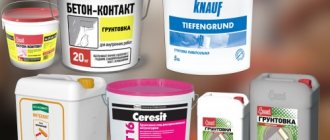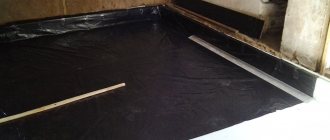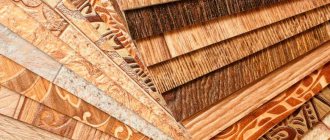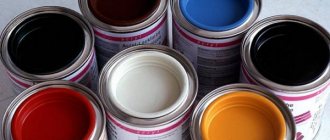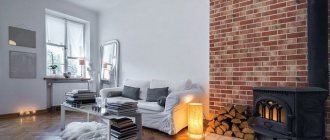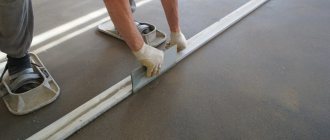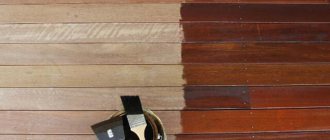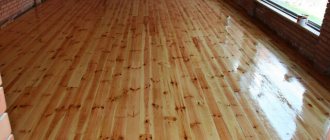Staining wood floors is one of the most common ways to finish them. But even with all its simplicity, it requires a competent approach, if only because the paint for the floor must meet certain criteria.
Floor paint
By the way, the wide variety of paint and varnish compositions presented in the assortment of stores can even make it difficult to choose the best option. Let's try to understand this issue in more detail.
Floor paint selection options
The main attention should be paid to such characteristics as:
- Type of wood;
- Purpose of the room (in the kitchen, in the hallway and in the bathroom, more resistant paint is required that is not afraid of high humidity; in residential premises, preference is given to the most environmentally friendly paints);
- Old coating (not all finishes will be compatible with the new paint coat);
- Harmless to humans.
Once these characteristics have been determined, you can begin to select the most suitable paint option.
Acrylic floor paints
The coating consists of water, acrylic resins and coloring pigments. This set provides:
- Eco-friendly and hypoallergenic;
- Fire resistance (an important indicator for wooden houses);
- Resistance to water, temperature changes, ultraviolet rays;
- Long service life;
- Ease of care;
- Plenty of room for imagination thanks to a wide range of colors;
- Easy to apply.
To obtain an even coating, floors will have to be painted in several layers, which significantly increases paint consumption and repair time. More expensive acrylic paints will save time as they allow you to apply just one coat. You can reduce paint consumption by using a spray bottle, but you can also get by with a regular roller.
Thanks to its attractive qualities, acrylic paint can serve not only in residential premises, but also in public organizations.
Preparatory work
In order for the surface to be painted to be smooth and beautiful, it must be prepared before painting. To do this you will need:
- remove dust and dirt from the surface using detergents;
- especially carefully clean the gaps and cracks from dirt;
- remove existing greasy stains with a solvent;
- level problem areas, especially uneven areas with a chisel.
It is also recommended to treat the surface with a protective layer of oil and wait for it to dry completely, which can take up to 3 days. After applying 2 or 3 layers of acrylic paint and it has completely dried, varnish or special oil is applied on top. This significantly increases the service life of the floor covering. If the painting is done according to all the rules, the wooden floor will serve for a long time and reliably.
Polyurethane floor paints
Most often, such paints are used for concrete surfaces and facade work, but can also be used for wooden floors.
The advantages of this type of finishing are:
- Resistance to mechanical damage;
- High wear resistance;
- Environmental friendliness of the materials used;
- Reliable resistance to fading, humidity, temperature changes;
- Good coverage density;
- Creating a perfectly flat surface;
- Small expense.
But, despite all its pleasant characteristics, this paint is used quite rarely.
The reason is the long wait for drying: depending on the room, the coating can dry up to two weeks. Not the most pleasant moment will be the need to mix the components yourself.
Good ideas and options
A wooden floor can be made original by painting the floorboards with multi-colored paints, as in this example.
And thanks to the design idea, well-chosen floor paint and other details, it is quite possible to decorate a city apartment in a rustic style - nice and unexpected.
In this interior, the green floor and the red sofa very successfully complement each other in such a way that it makes your soul even more cheerful.
The Scandinavian style can be called “all white” in another way: it includes walls, floors, and furniture. This is an ideal option for a dining room, as it emphasizes the sterility of the room.
Oil paints for floors
Until recently, this option was the most favorite and, in principle, the only way to paint the floor. The paint consists of natural elements: drying oil, oil, color pigments, therefore it is considered a safe dye for health.
The benefits also include:
- Fire resistance and moisture protection of the coating:
- Easy to care and apply.
At the same time, oil paints are seriously inferior to modern compositions in terms of:
- Durability;
- Wear resistance;
- Preservation of appearance.
Most oil paints are not capable of providing a bright finish. This point should be taken into account by people who find familiar colors boring and ordinary.
Rubber floor paints
This option is great for connoisseurs of new products. These paints consist of specially selected polymers that provide all the positive qualities of the coating.
These include:
- Cost-effective;
- Increased strength, able to withstand even significant mechanical impact;
- Thermal resistance;
- Calm attitude towards changing climatic conditions indoors;
- The ability to maintain rich color for a long time, despite the abundance of sunlight;
- Durability.
Rubber paints do not crack or peel during use; they are highly elastic, so they can easily withstand almost any physical load and perfectly fill the gaps between individual boards.
In this case, the paint layer does not interfere with the expansion or contraction of the wood. The pleasant material resembles soft rubber to the touch; it wonderfully softens falls (therefore can be used in children's playrooms) and cushions when walking, reducing the load on the spine.
The paint will last for 10 years, and in some cases it lasts without changing its appearance even longer than the established service life. A wide range of colors allows you to decorate the floor with a wide variety of shades.
Features of coloring board coverings
To obtain a respectable appearance of a wooden floor, regardless of the type of wood from which the board is made, careful preparation of its surface is necessary. It's about sanding and cleaning.
Products that will be used in the proposed master class on painting a board that imitates a plank floor covering.
If varnish or paint is applied to an unpolished surface, all its roughness and flaws will be revealed. And when using an oil or wax coating on an unprepared surface, nothing really will work.
The process of preparing and painting a wooden floor will be considered using the example of a plank board made in compliance with the technology for installing tongue-and-groove floorboards.
| Illustration | Brief description of the operation performed |
| An eccentric sander is used to sand the board. The first treatment is with sandpaper with a grit of P40 or P60, for the final pass - P120. | |
| After sanding the surface, it should be wiped with solvent. This process is especially important if the floors are made of pine boards, the structure of which, due to its resinous content, has the ability to unevenly absorb coloring compounds, that is, the coloring will turn out uneven. After treatment with a solvent, uniform coloring will be ensured, since it “works” inside the wood structure without creating a film on the surface. | |
| As mentioned above, paints, varnishes, oils and waxes are used to cover wooden floors. Oil and wax have an advantage over other materials in that they are deeply absorbed into the wood structure, so that floor repairs can be done in a separate area. If damage occurs to the varnish or paint layer, you will have to completely repaint it. Experts do not recommend applying too dark colors to pine or spruce, as the coating may become damaged during use and reveal the natural color of the material. The oil is applied to the wood in one to three layers, no more. | |
| Due to the fact that in this case a small area will be painted, the oil can be poured into small puddles and then distributed with a small roller and brush. Oil is also applied to the floors in the room using a roller, but of a larger size, and the oil is poured into a special tray that has a grooved surface for squeezing out excess. | |
| The oil is rolled out both along the grain of the wood and across it, but the final direction of the roller should be longitudinal movements. The composition is distributed until the textured pattern of the wood appears through it. | |
| The coloring composition can also be applied to small areas using a brush. Similar to the roller painting process, application can be done along and across the grain of the wood, but when finishing the layer, the paint is spread along the grain pattern. | |
| There should be no transverse brush strokes left on the painted surface. Oil-coated wood should be left to soak and dry for about a day. After which the surface must be checked for dryness, and only then can the finishing coat be applied. | |
| To check the surface for dryness, you need to take a clean, light-colored napkin and wipe the painted boards with it. There should be no trace of the dye composition left on the fabric. | |
| If the napkin remains absolutely clean, then you can proceed to the next stages of work. | |
| Before applying the next coat of paint or wax, it is necessary to sand between layers. To do this, you will need a construction float with a fine-grain emery attachment. | |
| Sanding is done without much pressure on the surface, moving along the grain. In this case, the color of the floor should not change - the task of sanding is to remove the fluff that has risen during painting. The board should remain absolutely smooth. After this, dust off the surface using a clean soft cloth. | |
| The next step is to apply one layer of transparent protective oil, with a dry residue of about 90%. | |
| To complete the work, a small puddle of oil is poured onto the surface, and a polishing patch is placed on top of it. A grinder is installed on it, with the minimum speed set, and the oil is distributed over the surface - polishing. The process is carried out in a circular motion. | |
| If there is excess of the applied product remaining on the board, which is no longer absorbed into the wood, you need to replace the oil-soaked patch with a dry one and walk it along the surface, along the grain. | |
| It is easier to sand floors with a tool that resembles a mop, to which an emery attachment is attached with Velcro. The movements during grinding are made along the fibers. After sanding, the surface must also be cleaned with a dry cloth attached to a mop. | |
| Instead of recoating and polishing with professional oil, a special wax-oil with an average solids of 50% can be applied. This product must be applied in at least two coats. To ensure that the color of the floor remains saturated after this operation, 10% of the paint composition should be added to the wax-oil. | |
| The finished composition is poured into a tray for easy collection with a brush, which, if necessary, is pressed onto the relief plane of the container. | |
| The composition is applied in the direction of the structural fibers of the wood, using back and forth movements. After this layer has dried, a colorless finishing composition is applied on top of it in the same way. The painted floor is left for about two to three days until completely dry. If other repairs are planned in the room, then they can be carried out seven to ten days after applying the last layer. This is due to the fact that the final drying feature of the combination of compositions - varnish, oil and wax. In this case, the floors should be covered with dense polyethylene, and movement on them should not be allowed. |
* * * * * * *
We hope that the information obtained in this article will help you decide on the choice of floor paint and the basics of its use. In any case, if the manufacturer indicates on the packaging of paints and varnishes some features of the use of the composition, then you should adhere to them.
Let’s finish the article with a video in which an amateur craftsman shares his experience in painting floors.
Alkyd floor paints
These types of floor paints have a similar composition to acrylic coatings, but the resins in them are alkyd substances. This option provides a luxurious glossy finish that attracts attention and fills the room with light.
Among the advantages of alkyd paints are:
- Quick drying;
- High adhesion, thanks to which the paint penetrates deep into the wood, protecting it from unfavorable living conditions;
- Calm attitude towards moisture and temperature fluctuations;
- The presence of antibacterial properties that help save floors from mold, bacteria, fungus, rot;
- Resistance to ultraviolet rays;
- Long life, without losing its attractive properties and attractive appearance.
Alkyd paint is the happy owner of a bright and rich color until the end of its service life.
However, paint is not very often used for painting residential floors.
The disadvantages of this coating are:
- A pungent odor that lasts until the paint dries completely;
- Instability to chemical floor cleaners;
- Lack of fire resistance.
It is best to use such paints in rooms with high humidity.
Wear-resistant floor paints
This is a separate category of paints characterized by increased wear resistance. They are produced on the basis of acrylic materials, therefore they retain all the advantages of this segment of floor paints. LMB have:
- Increased hygroscopicity;
- Easy to apply to any surface;
- High resistance to all types of damage.
In addition, the paint dries quite quickly and does not have too strong a smell.
The choice of materials for painting the floor is quite large, so before you go to the store, you need to decide on the required characteristics. And then the painted floor will delight its owners for a long time.
New
Protective layer of varnish
New wood floors that have never been painted leave more room for choice.
If you want to preserve the color and texture of wood, then give preference to colorless varnishes with good wear resistance. If the natural color of the parquet boards or strips differs in color (in some places on the surface), it is better to use a tint varnish that will hide this not very pleasant nuance.
Video
When choosing the best way to paint the wooden floor of a country house, be sure to find out what kind of wood it is made of. The fact is that some tree species have soft wood (for example, pine), on which even a thin female heel easily leaves a dent. Therefore, you need to choose a special varnish for coating (for soft wood or strictly for a specific type of wood). Simple parquet varnish will not work in this case, since it is designed for durable and hard wood (mainly oak).
The methods of applying varnish also differ:
- parquet varnish is applied with the obligatory preliminary priming of the surface (purchase the primer immediately in the store, and it is advisable that it be from the same manufacturer as the varnish you have chosen);
- floorboard varnish is simply applied in three layers, each of which must dry completely.
Wood floor tinting
If, according to the design plan, your floor should have a certain shade, you can choose one of two methods:


